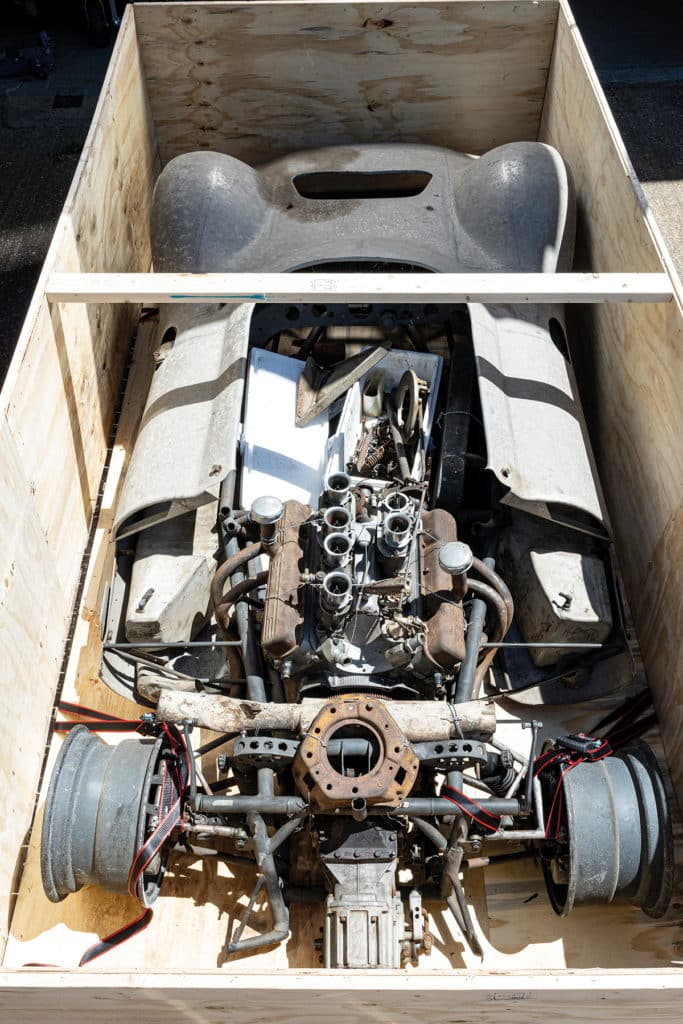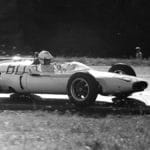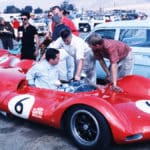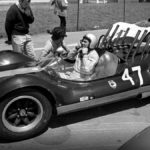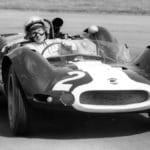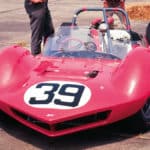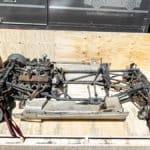Matters of Moment: First McLaren returns home
Readers of this magazine will be familiar with the ‘Zerex Special’, the Holy Grail of McLaren’s early years. Now the original car has been uncovered and shipped back to Britain

Bruce McLaren at the wheel of the Cooper-Zerex-Oldsmobile on TT pole at Goodwood
One of motor racing’s most iconic ‘long lost’ classic sports-racing cars was unpacked in June, on its return to British soil for the first time in 57 long years. The car is the late, great Bruce McLaren’s 1964 Cooper-Zerex-Oldsmobile – nicknamed in period ‘The Jolly Green Giant’ and the first sports car to carry his legendary Kiwi team badge.
This car is the taproot of the entire McLaren marque. After some 50 years inactive and dismantled in obscure South American storage, it will be offered for sale ‘as is’ by Bonhams’ auctioneers at the Goodwood Revival Meeting.
For discerning 1960s racing-car hunters this Cooper-Zerex-Oldsmobile is something of a Holy Grail, having effectively vanished after achieving tremendous premier-level success, and not only in McLaren’s hands. In progressively developing form it was driven by illustrious American stars Walt Hansgen and Roger Penske in 1961-63, before being acquired by Bruce McLaren for his embryonic new racing team.
The car actually began life in 1961 as a four-cylinder 1½-litre Formula 1 Cooper-Climax T53P, entered by Briggs Cunningham for Hansgen during the 1961 United States Grand Prix at Watkins Glen. It crashed there, Cunningham selling it unrepaired (for $1250) to fast-rising star Penske.
Forward-thinking and ingenious, he had it repaired and rebuilt by mechanics Roy Gane, Harry Tidmarsh and Jock Ross as a lightweight “Grand Prix car thinly disguised in sports car clothing”. They retained its centreline driving position within a sleek streamlined wheel-enveloping body. It was christened the ‘Zerex Special’ after Penske’s DuPont anti-freeze brand sponsorship, and – using a 1961 Indy-derived 2.7-litre four-cylinder Coventry Climax FPF engine – Penske dominated US professional sports car racing, winning the 1962 Los Angeles Times Grand Prix at Riverside, and the Pacific and Puerto Rican GPs at Laguna Seca and Caguas.
“McLaren’s Cooper had trailed the Zerex twice, so Bruce bought it”
American regulations were changed for 1963 to block the centre-seat car, tellingly nicknamed the ‘FUBAR’: standing politely for ‘Fouled Up Beyond All Recognition’. Penske promptly had it converted to a conventional offset driving position, sold it to young Texan entrant John Mecom Jr, and drove it for him to win the 1963 races at Marlboro and at Cumberland, USA, plus the major international Guards Trophy at Brands Hatch.
This 1963-spec ‘Zerex Special’ was produced by Gane excising the original F1 single-seater chassis’ parallel top longitudinal members and replacing them with wide-apart top rails. To unite them to the original F1 Cooper front and rear suspension-mounting frames, plumbing-style tight-S planform tube ‘bends’ were welded into place fore and aft.
Works driver McLaren’s Cooper Monaco sports car had trailed the ‘Zerex’ home at both Riverside and Laguna. So he bought it from Mecom for 1964, significantly together with a Traco-tuned lightweight alloy-block Oldsmobile F85 V8 engine. In between grands prix McLaren campaigned the sports car under his new equipe – imaginatively entitled the Bruce McLaren Motor Racing Team.
Using a similar 2.7-litre four-cylinder Climax engine to Penske’s, and with minor car modifications to match British and FIA regulations, Bruce won early-season sports car races at Aintree and Silverstone, before having the car converted from his own sketches to use the 3.5-litre Traco-Olds V8. Team mechanics Wally Willmott and Tyler Alexander removed the flexible curved-tube frame centre-section and welded in new straight tubes, including stiffening diagonals. Third-recruit team mechanic Howden Ganley recalls how the excised tubes were “just tossed out the back of the dirt-floor shed we were using at an excavator service depot site in New Malden and lost in the long grass”.
Only the extreme front and rear ends/suspension mounts of the original Cooper F1 chassis were retained, including the original foot pedal assembly – evidently shifted right of centre during Penske’s 1963 conversion – for this revised McLaren Cooper-Zerex-Oldsmobile iteration. There they are now, probably the very pedals on which Penske’s and McLaren’s feet danced so successfully.
The little team’s target was the handsomely paying Player’s 200 race at Mosport Park, Canada, on June 6, 1964. Upon completion the car was hastily finished in the only paint that Bruce’s PA, racing writer Eoin Young, could find in any shop open on an old-time English Sunday; garden-gate green. The pair promptly nicknamed their newly modified sports-racing car ‘The Jolly Green Giant’ – while it also sported a Kiwi silver nose-cum-centre stripe.
It was immediately shipped to Mosport, where McLaren won. An even more illustrious victory followed for Bruce’s then green-and-white liveried car – its V8 engine uprated to 3.9 litres – in the Guards Trophy at Brands Hatch on August Bank Holiday Monday, 1964, the basic car’s second consecutive victory there after Penske’s in ’63.
Bruce McLaren last drove it in the RAC Tourist Trophy at Goodwood, starting from pole position and not only leading Jim Clark’s Lotus 30 and Graham Hill’s Ferrari 330P, but also setting fastest lap before clutch failure.
“Bruce McLaren last drove it in the 1964 RAC Tourist Trophy”
Replaced by the prototype, entirely McLaren-built M1, the ‘Jolly Green Giant’ was sold for 1965 to Texan amateur owner-driver Dave Morgan. He campaigned it in US south-western events and at the annual Bahamas Speed Week into 1966 before selling it to Venezuelan racer Leopoldo ‘Leo’ Barbosa of Maracaibo. Barbosa contested local events with the car into 1968, possibly later. He sold it to race organiser and car dealer Guillermo ‘El Mono’ Montero, co-owner of Maracaibo’s Autodromo Internacional La Chinita, before finding an enthusiastic South American buyer in the current owner’s father. Long preserved in dismantled form, it has survived essentially complete and, apart from body panelling, remarkably original and with the frame itself – crucially – in startlingly good order.
After close and critical inspection, former mechanic/F1 and sports-car driver Howden Ganley remarked: “I have always felt privileged to have been Bruce McLaren’s third employee. Incredibly, it’s now 58 years since I helped Tyler and Wal convert the Penske Cooper-Zerex to accept the Oldsmobile V8 engine. I am certain it’s the real deal, in astonishingly good condition, too.”
One intriguing discovery is an apparent chassis number, obviously stamped hurriedly into the left-top chassis rail, just by the dash-panel junction. It reads, cryptically, ‘NZ 25438’ – undoubtedly ‘New Zealand’ then perhaps a significant date – 25 April 1938? That doesn’t match the birthdates of any of the major players, but Howden suggests possibly that of a wife or girlfriend. The revamped frame would have required some form of ID when first hurried overseas to Mosport, or perhaps this was stamped when sold to Dave Morgan?
As a matter of Motor Sport moment, this car’s return to the UK is hard to beat.
The many faces of the ‘Zerex Special’
We trace its roots from F1 to sports car
1. As new
It began as an everyday Cooper T53, chassis F1-16-61. Walt Hansgen raced it in the 1961 United States GP but crashed.
2. Reclothed
Roger Penske bought the wreck and transformed it into the centre-seat ‘Zerex Special’, here at Riverside, 1962.
3. Re-regulated
Now a serial winner, rule-makers demanded sports cars have equal size seats, so Penske complied for 1963.
4. Home again
Bruce McLaren bought the still Climax-engined car for 1964, seen here during the Aintree International.
5. ‘Jolly Green Giant’
Determined to go one better than Penske, McLaren fitted a big 3
6. Big banger
With 3.9-litre V8 and top-ducted nose, McLaren led the 1964 Goodwood TT but was out after 18 laps with a clutch issue.
7. Texan anteater
With F1 beckoning, McLaren sold the car to Dave Morgan, who raced it in America and the Bahamas before selling it on.
8. Prodigal son returns
After 50 years in South American storage, the ‘Zerex Special’ returns to the UK, and is now for sale… again.
